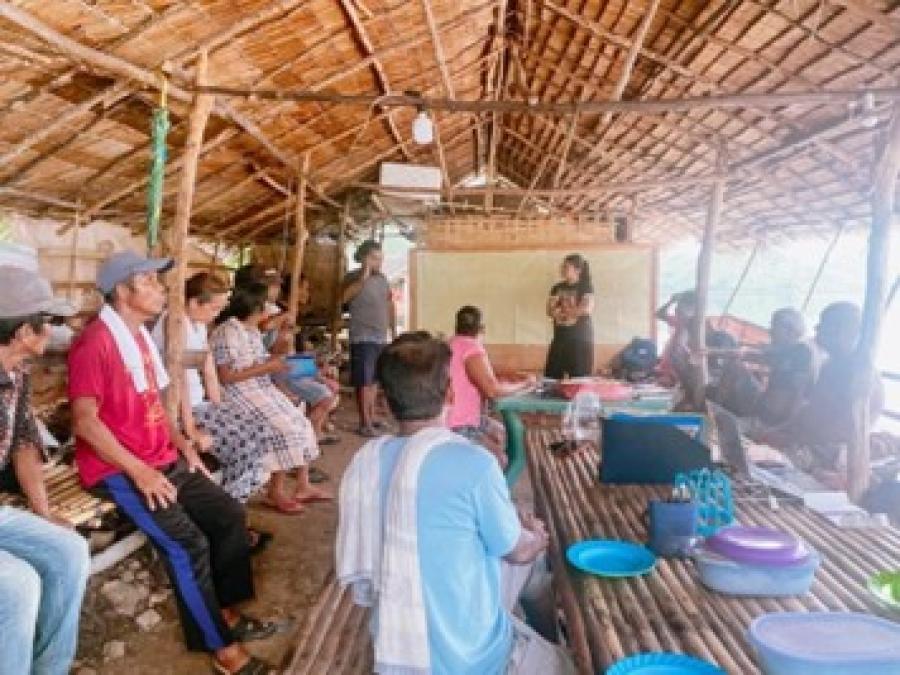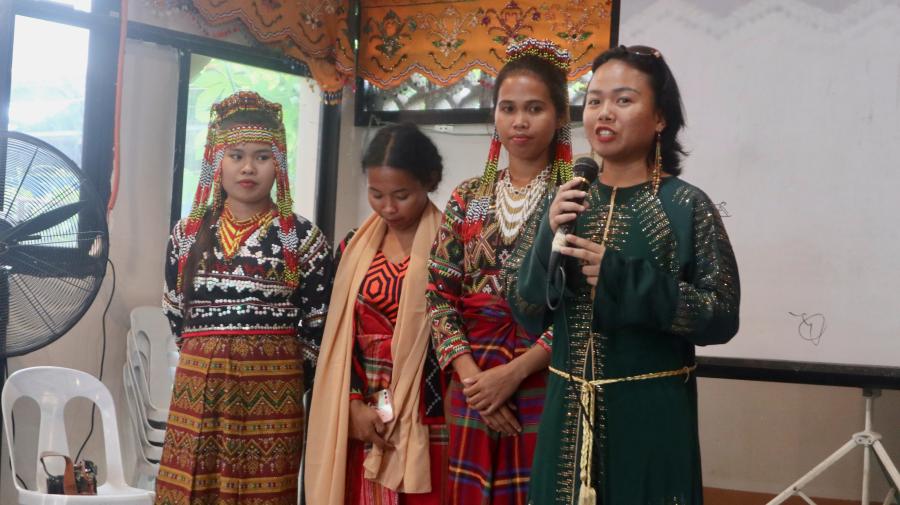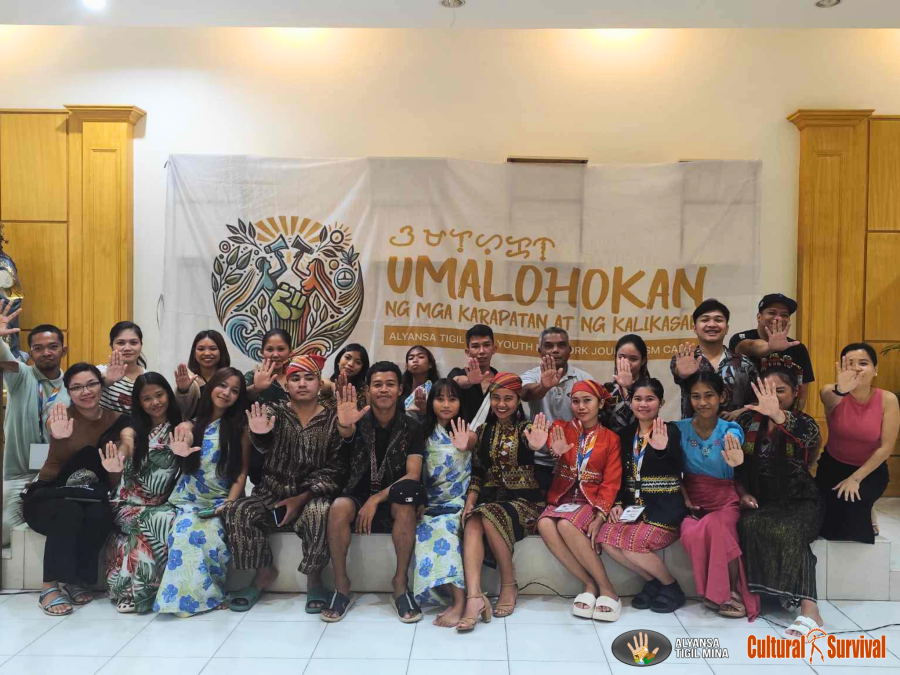In the Philippines, three Hanunoo communities have initiated an alternative education program to standard Philippine education. It is hoped that an education more sensitive to their culture will enable Hanunoo to develop skills essential for self-determination in their changing world. Organizing the new school has called for collaboration between Hanunoo, external support agencies, teachers and administrators. A ten-year project illustrates the importance of such collaboration and the need to base educational systems on the expressed needs of the community served by this school.
Background
Hanunoo are one of several Mangyan cultural groups indigenous to Mindoro Island, Philippines. As lowland Filipinos have migrated to Mindoro searching for arable land and other economic opportunities, Mangyan peoples (e.g. Hanunoo, Buhid and Iraya) have become ethnic minorities. The Hanunoo of south central Mindoro have attempted to maintain their autonomy by retreating from the coastal lowlands to the rugged forest interior of the island. No roads penetrate into the Hanunoo area; it is accessible only by steep trails.
In the uplands, most Hanunoo continue to grow bananas, corn and tubers such as cassava, sweet potato, yams and taro although the most culturally valued food crop is rice. Forest foods supplement the Hanunoo diet.
As the lowlands have been settled and developed, cash has become essential to Hanunoo. To generate cash, they sell some rice and forest products to lowland entrepreneurs, cattle ranchers and paddy rice farmers as well as going to work for them. Consequently, most households experience food shortages at various times of the year. This in turn directly affects their health and agricultural productivity.
The ratio of Hanunoo to land has increased with the influx of colonists. Increased population density has changed the traditional land tenure system. Formerly, each household had rights to use uncultivated land. The farmer only owned the crops, not land. Households now make relatively permanent claims to plots they cultivate although, because most Hanunoo ancestral land is within the so-called "public domain," it cannot be titled. Claiming land may result from colonization, but it also gives households authority over specific areas, thereby discouraging colonists from squatting on agricultural lands. Repeatedly, lowlanders have shown Hanunoo pieces of paper purported to entitle the holders to Hanunoo land. Most Hanunoo do not read or write in Pilipino and English and may accept the lowlander's explanation of such "deeds." Symbolically and pragmatically, ancestral land is valued by Hanunoo, and the loss of land has fostered fear among the Hanunoo about the fate of future generations.
Typically, Hanunoo live in clusters of several households. Fields are dispersed but usually within a few kilometers of the hamlet. Several neighboring hamlets form a community. Over the past ten years, Philippine government and community organizers have encouraged the formation of villages to facilitate Hanunoo "development." Village living has increased interpersonal conflicts, most notably among Hanunoo converted to various Christian denominations; it has led to sanitation and health problems, depleted potable water sources and other resources, and increased walking distance to swiddens. Recently, many households have abandoned their village homes and re-established consanguineal hamlets.
Education for Self-Reliance
In early 1981, three Hanunoo communities formed a corporate foundation to direct local development. The Pundasyon Hanunoo Mangyan, Inc. (PHM) provides approximately 250 households (about 1,500 people) with legal identity. An elected board of trustees with representatives from each community governs the PHM. Elected leaders are young but confer with elders and community members until a consensus is reached. The PHM and volunteers solicited the assistance of the Philippine Association for Intercultural Development (PAFID) to help Hanunoo formulate culturally and technologically appropriate strategies for sustainable development.
After land security, education is the most urgent need expressed by Hanunoo. Leaders and community members are dissatisfied with standard public school education, primarily because it is culturally inappropriate. Lowland teachers and classmates harass and belittle Hanunoo children. Boys are prohibited from wearing the loincloth and are encouraged to cut their long hair. Many Hanunoo observe that children who persist in their studies beyond a couple of years tend to become "Pinoy Mangyan," a derogatory description for an individual influenced by lowlanders and no longer considered to be a "real" Mangyan. Such a person does not fit well in their home community when they return. Skills important to Hanunoo for dealing with the external world are not central to the elementary curriculum; as a result, a lowland educated Hanunoo has very little to contribute to his/her community.
One of the greatest conflicts Hanunoo feel about formal education concerns the daily removal of children from the family for long periods. The conflict between household solidarity and the need for education involves compromises at an individual, household and community level.
Hanunoo requests for assistance in educational development include a call for instruction in English and arithmetic. This will help Hanunoo secure land, develop a core of leaders who can work effectively for Hanunoo welfare within the larger society and help people cope with life in contemporary Mindoro. For the Hanunoo, coping with change involves efforts to maintain continuity with Hanunoo heritage, improve technical skills, strengthen familial ties and increase happiness by remaining near loved ones.
School Project Planning
Equipped with social scientists and educators experienced in upland research and minority education, De La Salle University (DLSU) in Manila became the primary external agency to assist the PHM to meet its need for formal education. PAFID and Peace Corps volunteers working with the PHM contributed to brainstorm sessions and project planning. Several PHM leaders traveled to Manila to attend and participate in numerous planning meetings. Meetings were rotated from the university to PAFID and the Ford Foundation so Hanunoo became familiar with each Manila-based agency. Hanunoo leaders' participation was critical to establishing the PHM's position in the project and providing a much needed reminder that the school is a PHM project and not PAFID's or DSLU's project.
The 12-month-long debate during which the proposal was written and revised many times tried Hanunoo patience. To Hanunoo, it was inconceivable that a "school" could become a complicated and multifaceted project. The complications were a reflection of the need to coordinate the Hanunoo's needs with those of the educators' as well as the social scientists' difficulty in responding innovatively to Hanunoo needs within the constraints imposed by formal education and funding agency's requirements. Over a ten-year period (1983-1993), the goals were defined as follows: to provide the Hanunoo with appropriate, functional education; to encourage individual and ethnic confidence and pride; to retrain teachers from northern Luzon ethnic groups to serve as the initial teachers and to identify several Hanunoo for parateacher training in order to eventually assume responsibility for the school; to finance the school through agroforestry projects; and to develop and test an education system that is a viable option for tribal Filipino communities nationwide.
The project was complicated by the fact that few Hanunoo have received secondary or university education. Those individuals who have been formally educated have been marginally incorporated into lowland Filipino society. Thus, there were no school teachers among the Hanunoo. PAFID proposed to the PHM that teachers be recruited from northern Luzon cultural groups who would be interested in living with and teaching other minority populations. Their cultural heritages are different, but as minorities, they share many problems and life experiences.
PHM leaders took turns traveling from the hills of Mindoro to Manila. They scheduled these trips around agricultural activities of field preparation, cropping and harvesting. These trips were difficult; the long-haired and loincloth-clad leaders were subjected to much verbal abuse while traveling. Memorandums were sent to all university offices explaining the school project and requesting that students be advised to show PHM leaders respect. This altered, to some extent, behavior of students and university personnel. It was not possible, however, to effect change in Metropolitan Manila at large. As a consequence, leaders wore trousers and t-shirts while travelling. Shy and unsophisticated in urban ways, leaders required a guide for all their travels in Manila.
After a year, meetings were transferred to Calapan, the provincial capital of Oriental Mindoro. Calapan, many times smaller than Manila, provided a context for the leaders to more gradually develop the skills and confidence needed in urban settings. Manila-based project participants travel to and from meetings in Calapan easily in one day.
Two agencies - the Ford Foundation/Philippines and Foster Parents Plan/Mindoro - contributed to the project and served as mediators. The Ford Foundation provided nearly $100,000 for the first two years of the project. The grant was made to the Integrated Research Center, De La Salle University because the Foundation deemed the PHM to lack sufficient experience and management skills to assume responsibility for a large grant. Foster Parents Plan provided financial assistance directly to the PHM for infrastructure (e.g., school building and teachers' house). Prior to funding, most expenses were assumed by De La Salle University under the Participatory Upland Management Program and to a lesser extent by PAFID.
Several field trips were made by PAFID and DLSU personnel to the PHM area. These trips served to familiarize the agencies with the people and place. Each Manila visitor was required to stay alone with a Hanunoo family. This facilitated interaction and rapport between visitors and Hanunoo.
Prospective teachers were also taken to the area as a key component of the teacher selection process. Prospective teachers were observed interacting with Hanunoo; each was encouraged to share his/her philosophy of education, assess appropriate education methods, observe Hanunoo life and environment and develop impressions about the "job." Three teachers from different ethnic groups were selected, and into the second year of school they remain committed to the Hanunoo and teaching.
Hanunoo committed to educational development and their people have been recruited for parateacher training. The parateacher candidates who have had some elementary schooling are enrolled in the accelerated parateacher program for cultural minorities at Notre Dame of Marbel College, South Cotabato province, Mindanao. This program is funded by UNICEF to provide Mindanao's ethnically diverse population with empathetic and dedicated teachers. The Hanunoo parateachers will assume responsibility for the PHM school.
Project Implementation
Prior to the opening of school, the three teachers spent a month getting to know the communities, enrolling students, beginning to learn the Hanunoo dialect and discussing school plans with the Hanunoo. In order to formulate a tentative plan and curriculum, the teachers had spent several months researching education methods and curriculum development. This entry period established a collaborative relationship between teachers and Hanunoo in working toward a culturally appropriate school. The entire PHM became incorporated into school participation, fostering greater awareness and enthusiasm. Previously, leaders, parents and children had not fully understood all the planning and preparation. The leaders' presence at Manila meetings was viewed by some as a token concession to the mandate of participatory development. With school's opening, Hanunoo were enthusiastic and supportive of the teachers and the program. Leaders' participation from project inception was crucial in sustaining local contributions and interest.
Hanunoo were responsible for determining the location of the school building and for constructing it. It was wrongly assumed by external agencies that the PHM would build a school of local lightweight materials. The PHM instead chose a permanent structure of wood, concrete reinforced posts and a galvanized iron roof. Because they lacked carpentry skills, they employed a lowlander to cut lumber and a Peace Corps volunteer supervised the school's construction. The building was to be completed shortly after the school's opening; however, there were numerous delays. For most of the first year, the teachers held classes in the health clinic, granary, outdoors and later in a makeshift school where rain penetrated a thinly thatched roof. The galvanized roof of the now-completed school is hot on sunny days and noisy on rainy days. Nevertheless, it was chosen by the PHM and they are proud of it.
Educators advised the Hanunoo that there could be only one school for the three communities during the experimental phase. Each community is separated from the others by an hour hike along steep trails. The PHM repeatedly debated over possible locations. At one point, the school and teachers' house were to be built in a central location. This plan, however, was abandoned because of concern for the teachers' safety and their incorporation into the communities. It was eventually decided that the school would be built in Umabang, the most cohesive community. Umabang is smaller than Bailan but was chosen due to the fact that there were fewer intracommunity conflicts. Bailan residents remain dissatisfied about the decision. A plan was formulated between Bailan and Umabang for the housing and feeding of Bailan's children. Bailan children, however, are not attending school. Resentment and household food and labor shortages are the primary forces behind Bailan's lack of participation. Umabang's more energetic and assertive trustees may have forced the decision so that within the PHM the decision was not a consensus.
Theoretically, the external participants contend that participatory development is qualitatively superior to top-down development because it facilitates sustainability and acceptability. These agencies, however, have required frequent reminders that the school is the PHM's project. The PHM's Peace Corps volunteers and teachers have continually negotiated for the PHM's participation and right to veto. A policymaking body for all external inputs was formed to resolve conflict and to monitor and prepare reports. The ad hoc coordinating committee is composed of two persons from each PAFID and DLSU, a Peace Corps volunteer assigned to the PHM and a Ford Foundation representative. Because it was not possible to convince external agencies that the PHM should have a minimum of one position on the committee, the volunteer's primary role is to represent the PHM. The ad hoc committee without the PHM's input is in direct conflict with the participatory mandate which continues to guide the project. While external agencies are committed to grassroots development, they must schedule project activities around busy schedules (e.g. other development and research projects, teaching and domestic and international business travel). As a consequence, efficiency and expediency are valued even when it is well known that the dialogue central to meaningful participation takes time and patience.
Recently, a health component funded by USAID was introduced. De La Salle University believed it would enhance the school program. The Hanunoo cope with numerous health stresses and are receptive to attempts to address these problems. Each community has traditional healers and informally trained paramedics able to deal with most common problems (e.g. births, malaria, wounds, gastrointestinal disorders). These Hanunoo health workers were not consulted nor included in the planning and implementing phases of the health program despite the fact that they are most knowledgeable about local health needs.
Conclusion
Hanunoo - children and adults - from Umabang, Amindang and several communities outside the PHM regularly attend school. Students' progress has exceeded teachers' expectations. The parents are supportive and encouraging of both their children and the teachers. The teachers seem to enjoy their work and have adapted to the cultural and environmental setting. A lowland Filipino social scientist who has discarded his jeans for a loincloth resides in Umabang for the purpose of documenting the PHM school and its impacts.
Visitors from DLSU and other agencies come and go yet Hanunoo and teachers remain. Among other subjects, Hanunoo enjoy learning English. With new skills, they expect to be able to assertively defend their land rights. The PHM's communal forest lease application for more than 4,000 hectares of ancestral land has been negated by the Ministry of Human Settlement's acquisition of substantial portions of Mindoro's "public domain" lands from the Bureau of Forest Development (Lynch 1984). It remains unknown whether Hanunoo will have the opportunity to negotiate for legal recognition of their ancestral lands with the Ministry of Human Settlements. Without land security, the Hanunoo future is uncertain. The school fosters skills for self-determination but Hanunoo have yet to be permitted the opportunity to exercise this basic human right.
Article copyright Cultural Survival, Inc.



